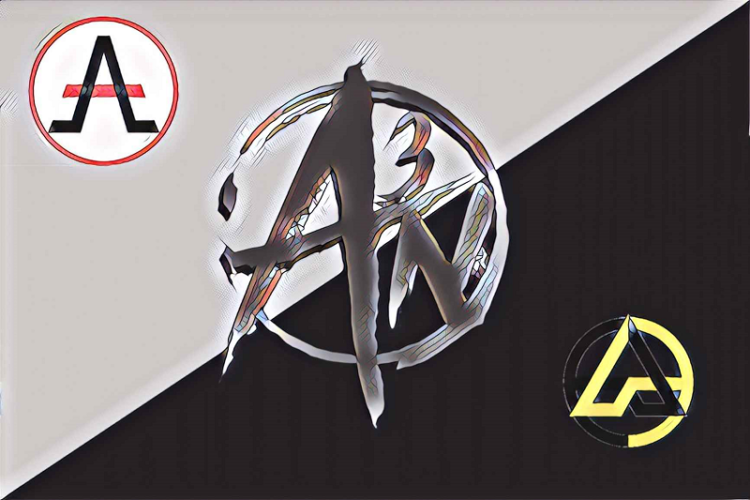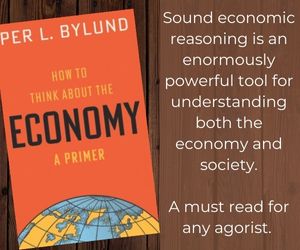
SEK3, Left Libertarianism and Anarcho-Capitalism, Part One.
Samuel E. Konkin III (SEK3, 1947-2004) is the father of Agorism—a free-market anarchism that envisions a peaceful revolution through counter-economics. Counter-economics consists of every non-violent human action that occurs without the State and within the private sphere. The actions that receive the most attention are those defying the State. SEK3 wrote, “The Counter-Economy includes the free market, the Black Market, the ‘underground economy’, all acts of civil and social disobedience, all acts of forbidden association…and anything else the State, at any place or time, chooses to prohibit, control, regulate, tax, or tariff.”
Agorists live their anarchism by refusing to cooperate with the State and by forging private alternatives to State “services” that have some value, such as mail delivery.
The modern movement known as Left Libertarianism claims SEK3 as an intellectual forefather. And, unlike the similarly claimed Murray Rothbard, SEK3 would not have been offended. He would have been flattered and viewed the credential as an opportunity to convert Left Libertarians more solidly to his vision. SEK3 had a conscious policy of embracing fellow travelers, even loosely defined ones, despite intellectual differences; the exception seemed to be people who worked for the State.
Does this make SEK3 a forerunner of Left Libertarianism?
Certainly, he sometimes referred to himself as a Libertarian Leftist, and the action-oriented branch of Agorism was called the Movement of the Libertarian Left (MLL). For their part, Left Libertarians draw on key concepts of Agorism, such as counter-economics, which further suggests a continuity.
Some close associates of SEK3, however, vehemently deny an intimate connection. The Alliance of the Libertarian Left felt it necessary to explain why it did not adopt the MLL label as a self-description. The Alliance announced,
“Inasmuch as the apparent executor of Konkin’s estate [J. Neil Schulman], who has since abandoned left-libertarianism as we understand it, now claims legal ownership over the term ‘Movement of the Libertarian Left,’ a need has been felt for new institutions, unaffiliated with the MLL, to carry forward what we see as the MLL’s authentic legacy. In brief, we consider ourselves the legitimate heirs of the MLL, but refrain (under protest) from using the label because of the threat of legal thuggery.”
The referenced “thuggery” was Schulman’s threat to sue the Alliance because its adoption of the MLL title would have distorted the original meaning. (Note: SEK3 adamantly rejected the alleged right of intellectual property; he would have rejected Schulman’s claim of ownership over any ideas or language associated with Agorism.)
Other close associates reinforce the connection to the Alliance, however; one is Wally Conger.
He and SEK3 co-authored an article entitled “Smashing the State for Fun & Profit” which appeared in the periodical Tactics of the Movement of the Libertarian Left. It was later published in slightly altered form as “Building a New Libertarian Movement.” The latter article opens, “The Movement of the Libertarian Left is Left both inside and out. We wish to abolish the State. We are uncompromising agorists—those who utilize only peaceful trade and voluntary interactions to attain our goals.” It continues with an attack on the corruption of libertarianism by the Libertarian Party that seeks “to govern to abolish government.”
Conger went on to explain, “’Left’, from earliest political times, has meant ‘anti-establishment’. Its core meaning is opposition. And since it is opposition in a political context (originally those opposed to the majority government in the French assemblée after the Revolution), it means opposition, at the least, to the current government and the Establishment, and at most, opposition to the State itself. Anarchists, whether collectivists or individualists, communists or agorists (marketeers), have always remained on the furthest Left.”
It is easy to quarrel with the definition of “furthest Left” as being anti-establishment if only because it excludes non-left anti-establishment traditions, such as Christian and Rothbardian anarchism. What is important here is taking the definition used by Conger and SEK3 at face value. Left is not defined by ideology so much as by the strength of its opposition to the state and the status quo; the stronger the opposition, the more Left the person or movement is seen to be. (Rothbard and his anarchist followers would reject this definition, of course.)
Schulman and Conger are polar opposites on whether or not SEK3 and Left Libertarians are part of a continuum in a fundamental way. Both movements wish to abolish the state, it is true. But, arguably, only agorists are consistent since many Left Libertarians espouse a Georgist single tax (or payment of rent) and some advocate a Universal Basic Income. Both proposals would almost certainly require a state-by-any-another-name to collect the tax and redistribute the wealth. This does seems to disconnect Left Libertarianism from Agorism.
For a continuum to exist, shared ideas and goals must lie at the center of each movement, otherwise the proper assessment is that SEK3 influenced aspects of Left Libertarianism—a statement no one contests. For him to be a forerunner, however, requires that essential principles of Left Libertarianism have developed from Agorism’s own. Assessing this claim means exploring the similarities and differences between the principles of SEK3 and Left Libertarians in order to judge whether he was an influence or a forefather.
SEK3 and the Left Libertarians
In 1978, the Movement of the Libertarian Left was formed as the primary action organization of Agorism, which had a very specific vision of society. The agorist Libertarian Left stood for a peaceful free-market anarchism, including private property and the acquisition of capital, through counter-economics. Through black and gray markets, agorists could weaken the state and render it irrelevant.
The goal was not purely economic. SEK3 believed an agorist society would be far more just in its operation and more equal in the natural distribution of wealth, opportunity and status within it. Two key factors would produce increased justice and equality.
First, without statist obstacles, such as licensing laws or monopolies, individuals would cooperate with each other more easily and on a more even footing. Second, corporations and other elites could not use state privilege to impose what he believed to be a feudalistic wage system on average people or otherwise oppress them. SEK3 vastly preferred an economy of entrepreneurs in which people owned the businesses in which they labored or functioned as independent contractors. To repeat: SEK3 thought an agorist society would not only be more prosperous but also more ethical and conducive to human nature.
SEK3’s goal of increasing equality—a version of social justice—is one of the main attractions of Agorism for Left Libertarians who are sometimes called egalitarian libertarians; this is the belief that all members of society should enjoy the same economic and social status.
There is a crucial difference, however, between Left Libertarianism and Agorism on this point: all members of an agorist society would not enjoy the same prosperity or social status. An agorist society would not be egalitarian and it was not a primary goal; freedom was. Some people would be far wealthier or much more highly regarded than others due to factors such as hard work, circumstance of birth, special talents, or dumb luck. SEK3 merely wanted to remove all artificial barriers to prosperity and personal fulfillment, which would liberate people’s natural tendency toward equality.
In a real sense, SEK3’s vision is closer to standard libertarianism which seeks to eliminate state involvement in all peaceful interactions and advocates egalitarianism only in the sense of people being equal under just law. He did not mandate proper social behavior per se beyond prohibiting non-aggression, nor did he spill a great deal of ink on the matter. He thought justice and equality would spread naturally under Agorism.
In Volume 4, Number 2, 1979 of Clear Ether!, SEK3 explained another reason why an agorist society would be more moral and just: the lack of conflict.
“A libertarian society is particularly lacking in it [conflict]. No unemployment since one needs a minimum wage law to keep people unemployed. No wars because you need governments to wage them. No elections or coups because there are no government leaders. No oppression because there are no police. No serious crime because property is protected efficiently as with any other business. No taxes because there is no government to collect or demand them.”
Whether or not this is correct, it was SEK3’s vision.
But, again, why did he call it the “Libertarian Left”? The word “libertarian” is the easy part to answer; the word refers to someone whose primary social and political commitment is to non-aggression. Agorism is one of purest forms of libertarian expression because it not only embraces peaceful means but also eschews all contact with the institutionalized aggression of the State, even if the contact is nonviolent such as applying for a license.
The word “Left” is more complicated because it springboards off SEK3’s view of the “Right” and the “Center.” (Note: SEK3 was not always a careful writer, and the meaning of terms like “center” shifted quite a bit over the body of his writing.) His classic work, the New Libertarian Manifesto (NLM), states, “The ‘Right’ of current libertarianism is fairly principled but many of the principles hewed to are anti-principles: gradualism, conservatism, reformism and minarchy.” SEK3 defined anti-principles as rules “that seem to be principles but are actually contrary to natural law”; that is, they are antithetical to the natural vested interest people have in their own autonomy.
In speaking of the “Right of current libertarianism,” SEK3 was primarily addressing the newly created Libertarian Party whose members he labeled minarchists. LPers accept a stripped-down state that functions as a night watchman to provide law enforcement, courts, and (perhaps) military defense. Minarchists accept statism, SEK3 argued, and this violates the natural law principles upon which their autonomy rests; they act on an anti-principle.
Minarchists also ignore or deny the historical inevitability of limited states evolving into larger and larger ones through the passage of time. SEK3 believed “the strategy of the first New Libertarians is to combat anti-principles which strengthen the State and dissipate anarchist energy uselessly.” The initial agorist strategy was to combat “right-libertarianism,” especially the LP. Conger put it succinctly. “I see limited-government minarchists as the right-wing of the libertarian movement. We anti-politics anarchists are its extreme left-wing.”
As for “Center Libertarianism,” SEK3 argued that centrism included the LP-era Murray Rothbard “and his following, who had organized to form the LP ‘Radical’ Caucus.” Despite their active participation in the LP, the Rothbardians were not right-wing because their support for Clark (the LP’s then-Presidential candidate) was strategic while their attitude toward him was basically hostile. They supported Clark “externally, but not internally”; that is, they leveraged their position within the LP in order to sabotage Clark’s authority and to act as a foil to him. The Rothbardian centrists seemed to adopt anti-principles by joining the LP, but they did not absorb them by using them as guidelines. By this standard, any libertarian who gives lip service to anti-principles but does not believe or act on them would fall into the center category. (Note: I disagree with this analysis. From personal contact, I know that Rothbard and several of the Radical Caucus sincerely believed in using the political means to further libertarian goals. Which particular candidate they backed is a secondary matter.)
The preceding explains why SEK3 rejected “Right” or “Centrist” to describe his new organization, but why he chose “Left” rather than some other qualifier needs scrutiny.
I asked SEK3 “why?” several times because the term Left Libertarian sat strangely in my ears. I had adopted the label “individualist anarchist” due to the influence of the Index to Liberty—Benjamin Tucker’s Liberty—on which I was working at the time. I was not attracted to or repelled by the words “left” or “right” because both political positions seemed equally statist to me. I was familiar with the merits and flaws of libertarian-socialism through Tucker and his associates, and many libertarians of my acquaintance were economists who were branded as right-wing because they argued for capitalism. Why did SEK3 favor one word over the other?
The question arose specifically about what was then a new a new project—MLL. I asked, “Why ‘Left’?” Why not the New Libertarian Movement after the title of his bedrock periodical, The New Libertarian? I was not the only one puzzled. In “Smashing the State for Fun and Profit Since 1969,” an interviewer asked SEK3, “Where did you get the idea to call your organization the Movement of Libertarian Left?”
SEK3 gave four reasons.
The first was emotional or psychological. SEK3 seemed to derive satisfaction from using radical symbols to stir people up. For example, he once produced red armbands with a large white circle outlined in black in the center; it contained a black flag with the words “Movement of the Libertarian Left” in small letters around the circle’s edge. He distributed the armbands to the “hard core” for them to wear in public. I was among several people who refused to do so because the armband was easily mistaken for a Nazi one, especially from a distance. When someone tried to convince SEK3 to abandon the whole idea, he dug in his heels more deeply.
A similar dynamic seems to have determined his choice of words. Rothbard and his followers accused SEK3 of using Marxist language, which was true. SEK3 referred to MLL members as “the cadre” or “the hard core,” for instance. He was delighted when someone told him that a person close to Rothbard “called me the Trotsky of the Movement. So it became natural to refer to us as the Libertarian Left in that context.” People and movements often convert an intended insult into a badge of honor; one example is the loco movement that advocated laissez-faire in the 1830s. SEK3 did something similar. When he was asked what “left-libertarian” meant, he often said it meant “to the left” of Rothbard.
The second and weightier reason was ideological.
SEK3 was profoundly influenced by the periodical Left and Right: A Journal of Libertarian Thought (1965-1968) that was edited and written mostly by Rothbard, with the active participation of Leonard Liggio. This periodical, along with the Rothbardian newsletter Libertarian Forum, fused the best of Old Right isolationism with New Left anti-imperialism. Left and Right described its mission; “the present-day categories of ‘left’ and ‘right’ have become misleading and obsolete,…the doctrine of liberty contains elements corresponding with both contemporary left and right.”
Those who wrote or actively contributed were anti-state, if not outright anarchists. Thus, both camps detailed the catastrophic impact of foreign invasion—whether through militarism or colonialism—and the equally devastating effect of invasions on domestic policy. Both lamented the crony capitalism from which the military-industrial complex was born. Differences in emphasis or points of theory could be viewed as more interesting than divisive. It is difficult to overstate the intellectual camaraderie established between those who came to Left and Right from both perspectives.
When the first issue of Left and Right appeared in Spring of 1965, SEK3 was a teenager. When Left and Right ceased publication in 1968, it left a gaping hole in the libertarian movement which an older SEK3 clearly realized and wished to fill. He wanted to be in the center of an alliance as Rothbard had been. His article History of the Libertarian Movement states, “In 1978, the Movement of the Libertarian Left was formed…to restore and continue the alliance Rothbard and Carl Oglesby had begun between the New Left and Libertarians against foreign intervention or imperialism.” (Oglesby was an academic and political activist who had once been President of the leftist student organization Students for a Democratic Society.)
In the ‘70s and ‘80s, it was common for radical libertarians to read, quote, and openly admire left-leaning scholars, especially revisionist historians like William Appleman Williams, who did ground-breaking work on American diplomacy, and Gabriel Kolko, who critiqued both Progressivism and the Cold War. Rothbard’s writing and speeches often credited leftist scholars for their analysis of state capitalism and imperialism, which also captivated SEK3. Left and Right used different terminology and applied somewhat different theories. When Kolko pioneered a fresh analysis and critique of corporatism—how America’s big business and government aligned for mutual profit—he referred to the arrangement as “political capitalism”; Rothbard called it “state capitalism”; SEK3 preferred “corporatism” or simply “corporations.” All three detested the unholy alliance, however, agreed on the basics of foreign policy.
SEK3 had modest but tangible success in recreating Left and Right. “History of the Libertarian Movement” notes, “Agorism had made the East European Marxist journals and was vigorously debated in the early 1980s.” The rapprochement was difficult to sustain. “The Original Gang Libertarian ranks [had] thinned considerably,” SEK3 lamented. “Robert LeFevre had died in 1986; Karl Hess left us in 1994 and Murray Rothbard in January 1995. The struggle for the minds (what was left of them) and hearts of the Libertarian Movement was thus engaged.”
The movement was moving to the right and toward anti-principles. As one of the last of the Original Gang Libertarians, the burden of continuity landed on SEK3’s shoulders. He established the New Isolationist newsletter that “combined the editorial skills and writings of Konkin and [libertarian E. Scott] Royce, with Alexander Cockburn and Noam Chomsky from the New Left, Thomas Fleming and Charles Reese from the Old Right, and many other anti-interventionists….With Chris Hitchens and Alex Cockburn calling for a revived New Left/Libertarian Alliance on CSPAN and in Left publications, SEK3 and…MLL answered them positively with the pamphlet ‘What’s Left?’”
SEK3’s third reason for using “Libertarian Left” was strategic. Indeed, Victor Koman—a close friend of SEK3 for decades and a hard-core resident of SEK3’s community, Anarcho-Village—believed the word choice was rooted in strategy. In a private email exchange, Koman explained, “I think he’d contend that his Movement of the Libertarian Left was (by his definition of ‘left’ and ‘right’) an early, at least, effort to tempt liberals away from socialism.” It was a sales technique.
Strategically, the name “Movement of the Libertarian Left” was also meant to segregate and immunize MLL from the backlash that his other publications and organizations encountered in the broader libertarian movement.
“We didn’t want NLA members who were building successful counter-economic enterprises to feel compelled to return to anti-political activism,” SEK3 wrote. (NLA refers to the New Libertarian Alliance—the basic organization for New Libertarian activists who tended to associate mostly with each other.) “So we made it clear it [MLL] was a different group who were willing to soil themselves working with non-agorists.” SEK3 was always careful to delineate the purpose and function of his various magazines and organizations, each of which expressed a facet of who he was and function of how to create an agorist world.
SEK3’s fourth motivation was to honor history. He recounted, “In 1978 I was fascinated with a group in France. Recall that in France then there were two large parliamentary alliances, and, unlike American political coalitions, these were highly ideological. But in the Union of the Left AND the Center-Right alliance, there were members of the once-dominant party of France known as the Radicals. They had a largely free-market position on economics.” A “left-wing” faction split off, calling itself The Movement of the Radicals of the Left. “I liked the sound and implication of that,” SEK3 continued, “so…our new aboveground activist group, to join forces with the ‘old’ New Left to fight” against war, “became the Movement of the Libertarian Left, or MLL.”
I would add a fifth reason. SEK3 had a deep attachment to the leftist counter-culture that was rooted in ‘60s and ‘70s hippie movement. The hippie’s counter-culture fit SEK3’s disposition and many of his beliefs. It arose in opposition to the Vietnam War, but had no interest in electoral or traditional politics. It championed non-violence—“Make love, not war”—as well as tolerance of social dissent in speech and action in contrast to the conservative mores of the day. It embraced alternative lifestyles. The hippie’s political philosophy was definitely left-wing, however, and hostile to right-wing ideals and causes, such as capitalism and traditional religion.
When an interviewer asked SEK3 about the counter-culture’s impact, he answered, “The hippie counter-culture had unacknowledged libertarian principles…and Libertarian activists from Kerry Thornley, perhaps the first conscious ‘Left Libertarian’…embraced it gladly.” SEK3 saw an enduring connection with the hippie culture, especially in the science fiction world in which he moved. “As far as I can tell, what remains of the Counter-Culture is almost entirely libertarian. The latest ‘alternative culture’ of cyberspace geeks is not just libertarian but outright agorist.” The attitudes and literature in which he reveled were viewed as a continuation of left-wing culture.
What Does It Mean to be a Forerunner?
Before exploring whether SEK3 was a forerunner or father of Left Libertarianism, it is necessary to sketch some criteria by which anyone becomes the forerunner of a broad movement rather than merely an influence upon it.
One guideline: the person’s impact must be somehow unique. This means the forerunner’s philosophy or his personal impact upon the movement must be singular and not likely to have been occasioned by another person; Ayn Rand’s impact on Objectivism exemplifies both conditions. The unique aspects of SEK3 world view are Agorism, complete with a singular presentation of class structure; neither existed before he envisioned them. By contrast, SEK3’s anti-statism and rejection of electoral politics is not unique; both positions have existed for centuries and in very similar form.
Another guideline: The influence of a founder should diffuse through most of the movement. That is, the impact should not be limited to one individual or to a few individuals who represent a minority. Rothbard is an example of such a diffuse influence. In the 60’s and ‘70s, when libertarianism was redefining and restructuring itself, few corners of the movement were untouched by Rothbardianism. Overwhelmingly, scholarship and activism revolved around expanding or rebutting his system. Without interviewing or polling Left Libertarians, it is not possible to know how widespread or pivotal SEK3’s influence has been. On an anecdotal level, however, many Left Libertarians seem to identify strongly with Georgism and a single tax, which is contrary to SEK3’s views. And, although Agorism is a prominent theme in some writing, it is not a dominant presence in the general literature.
It is always possible for a movement to have more than one forerunner, of course. Marx and Friedrich Engels co-founded the integrated system that is called Marxism which addresses every field of human study from economics to the family and the nature of revolution. Had they focused on one field alone—say class analysis—then their impact would have been limited and the movement would not be called Marxism. SEK3’s influence stems basically from one issue: Agorism. This suggests that his impact may be limited.
Another requirement of a founder, therefore, is that his influence must not rest on a single issue within a broad philosophy. Libertarian anarchism would not view the Austrian economist Ludwig Von Mises as a founder, for example, even though his economic contribution is immense. Rothbard has a far better claim to being a founder because he was a system builder whose system was popularly adopted.
SEK3 verged on claiming the status of system builder in the brief article “Agora v. Arena.” He considered the question,
“How does the world…look to a hard-core libertarian?” He answered, “Well, in general, it looks much like it does to everyone else… But there is one difference that we share with perhaps only the devoutly theological and the Marxist. We have a comprehensive social structure. When we look at a newspaper story, we integrate the facts into our social theory and draw conclusions. We see mighty and powerful forces, and sweeps of history.”
Whether or not this is true, Left Libertarians seem to have been relatively unaffected by other aspects of SEK3’s thought, such as aesthetics or ethics.
Ultimately, whether SEK3 was a founder of Left Libertarianism may rest upon how intimately connected his principles are to those of this movement.
[NEXT INSTALLMENT. Part Two compares SEK3’s principles to those of Left Libertarianism and Anarcho-capitalism.]







